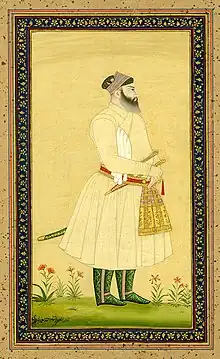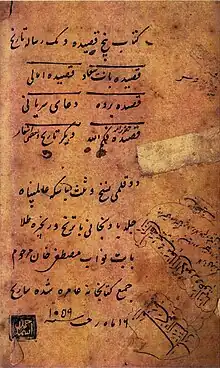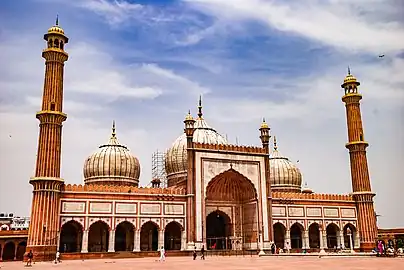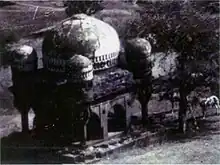Ustad Ahmad Lahori
Ustad Ahmad Lahori (c.1580–1649)[1] also known as Ahmad Ma'mar Lahori was the chief Mughal architect during the reign of emperor Shah Jahan. He was responsible for the construction of several of the Mughal monuments, including the Taj Mahal in Agra and the Red fort in Delhi; both of which are World Heritage sites.[2] He also designed the Jama Mosque in Delhi.[3]
Ahmad Lahori | |
|---|---|
 Miniature painting of Ustad Ahmad Mimar Lahori | |
| Born | c.1580 |
| Died | c.1649 (aged 68–69) |
| Occupation | Architect |
| Buildings | Taj Mahal Red Fort Old Delhi Jama Masjid, Delhi |
| Signature | |
 | |
Considered greatest of the Mughal architects,[1] Ahmad Lahori came from an illustrious family of architects and civil engineers. He was a skilled engineer who, owing to his architectural abilities, received the title of Nadir-ul-Asar (wonder of the age) from Shah Jahan.[4] His architecture is a combination of Indo-Islamic and Persian architectural styles, and thus a major example of Indo-Persian culture. The architecture of Taj Mahal is widely praised around the world, enabling it to be listed among the Wonders of the World.[5]
Life
The nisba "Lahori" indicates that he came from Lahore, Punjab, in the Mughal Empire. He has been described as a Punjabi Muslim[6] or an Indian of Persian heritage.[7] Even after his family's migration to Delhi, his family is still referred to by the epithet "Lahori".[8] In Muslim India, Lahori was used as a synonym for Punjabi by historic writers, such as Amir Khusro who uses it to refer to the spoken language of the people of Punjab, and the Mughal Emperor Jahangir who writes, "In fact they are pure Lahauris and speak the same language."[9][10]
Shah Jahan's court histories emphasize his personal involvement in the construction and it is true that, more than any other Mughal emperor, he showed the greatest interest in building new magnificent buildings, holding daily meetings with his architects and supervisors. The court chronicler, Abdul Hamid Lahori, writes that Shah Jahan would make "appropriate alterations to whatever the skillful architects had designed after considerable thought and would ask the architects competent questions."[11]

In writings by Lahori's son, Lutfullah Muhandis, two architects are mentioned by name; Ustad Ahmad Lahori[12][13] and Mir Abd-ul Karim.[14] Ustad Ahmad Lahori had laid the foundations of the Red Fort at Delhi (built between 1638 and 1648). Mir Abd-ul Karim had been the favourite architect of the previous emperor Jahangir and is mentioned as a supervisor, together with Makramat Khan,[14] for the construction of the Taj Mahal.[15][16]
Lahori had three sons: Ataullah (or Ata Allah Rashidi), Lutfullah (or Lutf Allah Muhandis) and Nurullah (or Nur Allah), who were also involved in architecture besides other fields such as mathematics.[17][18]
Career
Ahmad Lahori was learned in the arts of geometry, arithmetic and astronomy. According to his son Lutf Allah Muhandis, he was familiar with the Euclid's Elements and Ptolemy's Almagest.[4] In 1631, Shah Jahan appointed him on the project of construction of Taj Mahal. The construction project employed some 20,000 artisans under the guidance of a board of architects led by Ahmad Lahori. The complex took 12 years for completion.[3] Afterwards, he was relocated to Delhi where emperor ordered him for construction of the new imperial city, Shahjahanabad in 1639.[3] The building of the city, including the Red fort, was complete by 1648. In 1648, Ahmad Lahori started working on the project of the imperial mosque in Delhi, now known as Jama Masjid, Delhi. He died in 1649, before the foundations of mosque were laid.[3] The mosque was later completed by the architect Ustad Khalil.
- Ahmad Lahori's major works




 Covered Bazaar in Old Delhi
Covered Bazaar in Old Delhi
Legacy
- Ahmad Lahori was mentioned in the Indu Sundaresan's Washington State Book Award winning novel The Twentieth Wife.[20]
 Photograph of the potential tomb or grave site of Ustad Ahmad Lahori located in the Ambar complex of Khuldabad, circa 1860[19]
Photograph of the potential tomb or grave site of Ustad Ahmad Lahori located in the Ambar complex of Khuldabad, circa 1860[19]
See also
References
- Curl, James Stevens; Wilson, Susan (2015). The Oxford Dictionary of Architecture. Oxford University Press. p. 11. ISBN 978-0-19-967498-5.
- Yasin, Mohammad; Yasin, Madhvi (1988). Reading in Indian History. Atlantic Publishers & Distri. p. 89.
- Khan (Arshi), I. N. (28 August 2015). BLACK TAJ MAHAL: The Emperor's Missing Tomb. Black Taj Project. p. 38. ISBN 978-81-927479-0-3.
- Necipoğlu, Gülru (1 March 1996). The Topkapi Scroll: Geometry and Ornament in Islamic Architecture. Getty Publications. p. 155. ISBN 978-0-89236-335-3.
- "Taj Mahal". New7Wonders of the World. 13 July 2016. Retrieved 15 June 2022.
- The Sikh Courier:Volumes 9-12. Sikh Cultural Society of Great Britain. 1977. p. 16.
Nadir-ul-Asar Ahmad Mimar Lahori Shahjehani was also a Punjabi who designed the Taj Mahal of Agra
- Janin, Hunt (2006). The Pursuit of Learning in the Islamic World, 610-2003. p. 124. ISBN 978-0786429042. Retrieved 17 November 2021.
- Marmaduke William Pickthall, Muhammad Asad (1974). Islamic Culture: Volume 48. p. 24.
- Khan, Ahsan Raza (1977). Chieftains in the Mughal Empire During the Reign of AkbarAhsan Raza Khan. ISBN 9780896843769.
- Bharati Ray (2009). Different Types of History. Centre for Studies in Civilizations (Delhi, India). p. 204. ISBN 9788131718186.
- Koch, p.89
- Taj Mahal Description and Profile (Ahmad Lahori, architect of the emperor) UNESCO.org website, Retrieved 17 November 2021
- Begley and Desai (1989), p.65
- Asher, p.212
- Dunkeld, Malcolm, ed. (August 2006). "Construction history society newsletter" (PDF). Chartered Institute of Building website. Archived from the original (PDF) on 27 September 2007. Retrieved 17 November 2021.
- "Mystery of Italian 'designer' hanged in Lahore". DAWN.COM. 10 April 2011. Retrieved 14 March 2022.
- Chanchal Dadlani (2016). "Innovation, Appropriation, and Representation: Mughal Architectural Ornament in the Eighteenth Century". In Gülru Necipoglu; Alina Payne (eds.). Histories of Ornament: From Global to Local. Princeton University Press. p. 183. ISBN 9780691167282.
- David Pingree, ed. (1970). Census of the Exact Sciences in Sanskrit Series A. Vol. 1. American Philosophical Society. p. 39.
- Lahori, Arif Rahman Chughtai (2023). In Search of the Grave of Ustad Ahmad Mimar Lahori in the Cemetery of Khuldabad, Aurangabad (PDF). Chughtai Museum.
- Sundaresan, Indu (1 October 2013). The Indu Sundaresan Collection: The Twentieth Wife, Feast of Roses, and Shadow Princess. Simon and Schuster. ISBN 978-1-4767-6418-4.
Notes
|